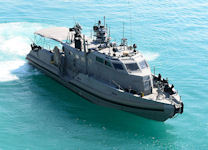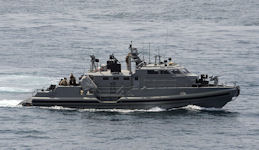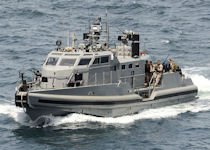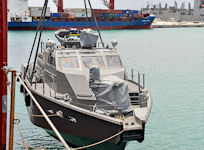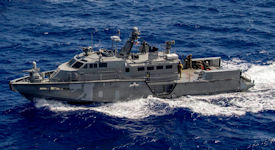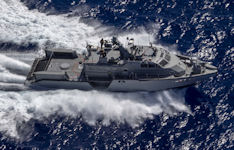Mark VI Patrol Boat / Coastal Command Boat (CCB)
The primary mission of Mark VI Patrol Boats is to provide capability to persistently patrol littoral areas beyond sheltered harbors and bays for the purpose of force protection of friendly and coalition forces and critical infrastructure. These missions include: security force assistance (SFA); high value unit (HVU) shipping escort; visit, board, search, and seizure (VBSS) operations; and theater security cooperation (TSC).
The 65-foot Coastal Command Boat (CCB) was a single early prototype of the 85-foot MK-VI Patrol Boat of SAFE Boats International. The CCB is powered by twin diesel engines and water jets, allowing of speeds of 35+ knots. Cruise speed can be maintained for up to 24 hours. It can accomodate up to 18 crew members and features integrated working stations along with a separate galley, head, shower facilities and engine room. The CCB is also equipped with remotely operated weapon systems, advanced thermal imaging and a hydraulic crane system. The first CCB was delivered in August 2013. The vessel was manufactured at SAFE Boats International’s Large Craft Production Facility (LCPF) at the Port of Tacoma, Washington and is one of the largest platforms the company has produced to date.
The Mark VI is the Navy’s latest acquisition in the Navy Expeditionary Combat Command (NECC) domain and is the first major redesign of a patrol boat since the 1980s. The Mark VI was engineered with a focus on decreasing total ownership cost (TOC) and manpower requirements. The major design elements of the Mark VI are an all-aluminum hull, enhanced performance, improved fuel efficiency, and armored plating protection for the engines and fuel systems. In addition, the Mark VI was designed with rapid transportability in mind, and its relatively compact size makes it possible to transport it on the U.S. Navy’s L-class amphibious ships. The Mark VI program of record is for a total of 12 boats, all boats were delivered by the end of the 3rd quarter of fiscal year 2018. The Mark VI was designed and built by American boat builder Safe Boats, International (SBI) for the CRF as a replacement for an aging fleet of patrol craft. In May 2012, the Navy awarded a $36 million contract to SBI to produce the first six boats. In July 2014, the Navy ordered an additional four Mark VI units, followed by an additional two boats one year later. By July 2015, the Navy had ordered 12 Mark VI boats. The 12th Mark VI was delivered to the Navy in January 2018 (Navy Recognition, 2018). The first two Mark VI boats were accepted by CRG-2 in September 2015. The Mark VI Patrol Boat, assigned to Coastal Riverine Group One, Detachment Guam (CRG-1 Det Guam) was offloaded at Naval Base Guam on 24 August 2016. CRG-1 Det Guam is assigned to Commander, Task Force 75, the primary expeditionary task force responsible for the planning and execution of coastal riverine operations, explosive ordnance disposal, diving engineering and construction, and underwater construction in the U.S. 7th fleet area of operations.
The MK VI patrol boats are now permanently assigned in two separate strategic areas of operations. In March, two MK VI patrol boats were delivered to CTF-56, based in Bahrain. The newest generation of patrol boat, the MK VI is a 85-foot combatant craft and provides a persistent capability to patrol shallow littoral areas for the purpose of force protection of U.S. and coalition forces, as well as safeguarding critical infrastructure.
"Innovative assets like the MK VI allow us to maintain maritime superiority and help strengthen and enable our partners within the Indo-Asia-Pacific region," said Capt. Erich Diehl, commodore, CTF-75. "We are excited to receive and employ the MK VI throughout our area of operations." The MK VI patrol boat offers the Coastal Riverine Forces a variety of mission sets, from waterborne to mine countermeasures to theater security cooperation, enabling operators to provide their critical security "know-how" and force protection worldwide. The U.S. Navy will utilize the MK VI patrol boats and their crews in a variety of Pacific Fleet exercises and operations.
Navy Expeditionary Combat Command's Cmdr. Raul Gandara emphasized the enhanced capabilities of the Navy's newest and next generation patrol boats. "The unique design of the patrol boats is its configurability, which will provide the opportunity for installation of future systems directly supporting the operational commander," said Gandara.
The MK VI patrol boats are globally transportable and can operate from amphibious ship well decks to forward locations, while partnering with allied navies at a new and more effective level. Additionally, the MK VI patrol boats will provide enhanced capabilities such as superior speed, range and maneuverability. The patrol boats can reach speeds in excess of 35 knots and have a range of more than 600 nautical miles.
The Coastal Riverine Force (CORIVFOR) operates in harbors, rivers, bays, across the littorals, and ashore. The primary mission of CORIVFOR is to conduct maritime security operations across all phases of military operations by defending high-value assets, critical maritime infrastructure, ports and harbors, both inland and on coastal waterways, against enemies, and, when commanded, to conduct offensive combat operations. CORIVFOR is a component of Navy Expeditionary Combat Command and provides flexible responsive maritime security forces capable of performing high-level security.
The Mark VI routinely deploys to isolated and austere environments. Even under a traditional Navy supply chain, these types of locations would present a challenge; however, the challenge is exacerbated under the current Mark VI manufacturer supply chain. The primary strategy the CRF employs to minimize material shortfalls during deployments is to pre-position a pack-up-kit (PUK) at or near the deployment location. The PUK consists of what the deploying unit determines to be the necessary replacement components that will be needed for the duration of the deployment. This PUK composition is based on the maintenance technicians’ experience and CRF leadership’s recommendations. The PUKs are not standardized and each squadron deploys with a PUK that contains different materials and components.
The operational tempo for the Mark VI is demanding, with an expected operational availability of 300 days a year. Although the Mark VI is a very capable platform, its rapid acquisition and employment has resulted in a logistics and maintenance framework that is underdeveloped, creating challenges for the Costal Riverine Force (CRF). Despite two annual Continuous Maintenance Availability periods for each vessel, by 2018 the Coastal Riverine Force was experiencing readiness shortfalls during deployments due to a lack of replacement material, prompting the analysis of the Mark VI patrol boat deployment supply chain. The majority of the high demand items are relatively inexpensive, generally small, and non-perishable. Therefore, there is very little risk associated with keeping them on-hand.
The Mark VI design has made significant advancements in capability, technology, and weapons systems from its predecessors; however, because of readiness shortfalls, the Navy was hesitant to purchase an additional 36 Mark VI patrol boats.
On June 17, 2020 the State Department has made a determination approving a possible Foreign Military Sale to the Government of Ukraine of up to sixteen (16) Mark VI Patrol Boats and related equipment for an estimated cost of $600 million. The Defense Security Cooperation Agency delivered the required certification notifying Congress of this possible sale.
The Government of Ukraine hadrequested to buy up to sixteen (16) Mark VI Patrol Boats; thirty-two (32) MSI Seahawk A2 gun systems; twenty (20) Electro-Optics-Infrared Radar (FLIR) (16 installed and 4 spares); sixteen (16) Long Range Acoustic Device (LRAD) 5km loudspeaker systems; sixteen (16) Identification Friend or Foe (IFF) systems; forty (40) MK44 cannons (32 installed and 8 spares); communication equipment; support equipment; spare and repair parts; tools and test equipment; technical data and publications; personnel training and training equipment; U.S. government and contractor engineering, technical, and logistics support services; and other related elements of logistics support. The estimated total cost is $600 million.
This proposed sale will support the foreign policy goals and national security objectives of the United States by improving the security of a partner country that is a force for political stability and economic progress in Europe. The proposed sale will improve Ukraine’s capability to meet current and future threats by providing a modern, fast, short-range vessel. Ukraine will utilize the vessels to better defend its territorial waters and protect other maritime interests. Ukraine will have no difficulty absorbing this equipment into its armed forces. The proposed sale of this equipment and support will not alter the basic military balance in the region. The prime contractor will be SAFE Boats International, Bremerton, WA. There are no known offset agreements proposed in conjunction with this potential sale.
| General Characteristics | MK VI Patrol Boat |
| Features |
|
| Propulsion | Installed Power: 5,200 HP -
|
| Length: LOA | 84.8' |
| Beam | 20.5' |
| Displacement | 170,000 lbs (full load displacement) |
| Draft | less than 5 ft |
| Speed | Cruise: 25+ Knots; Sprint: 35+ Knots |
| Range | 600+ Nautical Miles |
| Crew | |
| Armament |
|
|
NEWSLETTER
|
| Join the GlobalSecurity.org mailing list |
|
|
|


